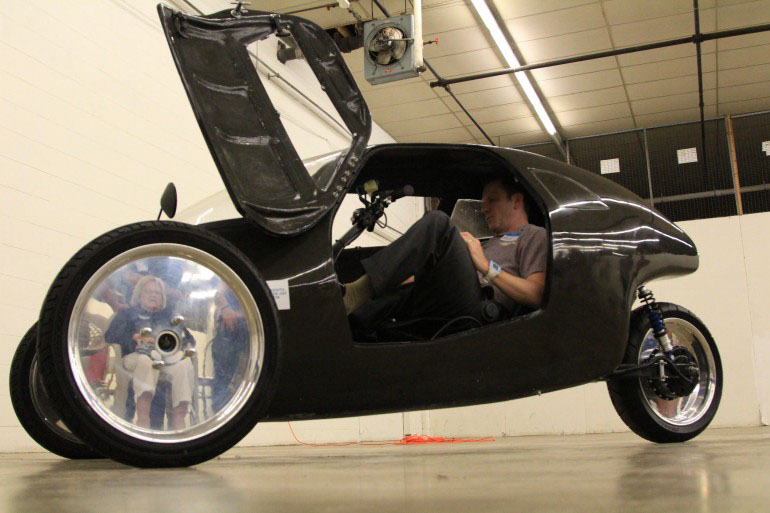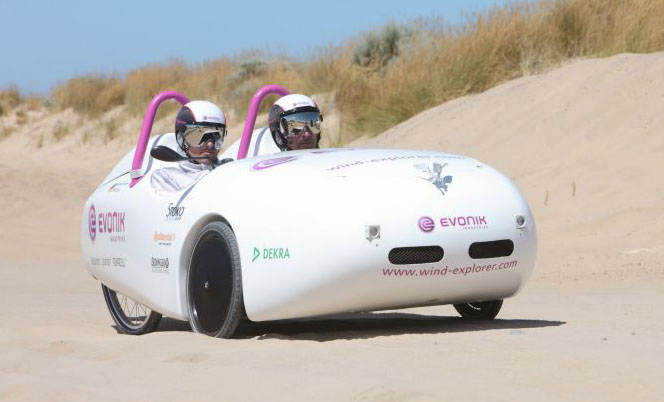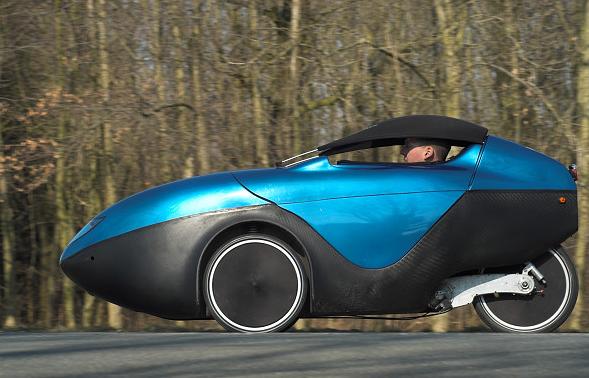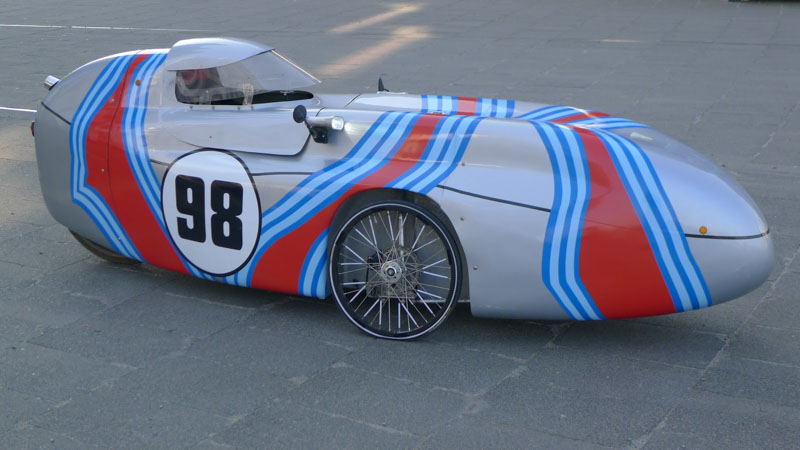If you missed last week’s post at Bicycle Design about velomobiles, be sure to check it out. In addition to the links that I mentioned in the body of the post, a few of you shared additional interesting velomobile designs in the comments sections. I ended that post saying “whether you call them velomobiles, HPVs, or even human powered cars, it is great to see pedal powered machines stealing the show in Detroit.” The answer to that question of what exactly you should call these vehicles isn’t always clear, and it become even less so when you consider the numerous electric assist models on the market. Enclosed pedelec vehicles ranging from the practical Organic Transit ELF to the speed-focused Raht Racer (Recumbent Human Automobile Transit) blur the lines between a traditional velomobile (basically a recumbent bike or trike with an aerodynamic shell) and a lightweight electric car. Perhaps we should just view these vehicles as a completely separate sustainable personal transportation category, and dispense with the comparisons to bikes and cars altogether. Maybe…but for now let’s do compare.
Low Tech Magazine addressed some of those category questions in 2010 with an excellent article titled, The velomobile: high-tech bike or low-tech car? (thanks to Adolfo for sharing that link on the Bicycle Design Facebook page).Toward the beginning of the article, they compare human powered velomobiles to standard upright bicycles, with a chart to illustrate the incredible efficiency of the former.

Raht Racer- “an electric-assist velomobile that amplifies the rider’s pedaling power, reportedly allowing them to move as fast as the cars around them.” Image via Gizmag
“The power output required to achieve a speed of 30 kilometres per hour (18.6 mph) in a state-of-the-art velomobile (the Quest) is only 79 watts, compared to 271 watts on a normal bicycle.”
“Pedaling at a speed of 30 km/h thus requires 3.5 times less energy with a velomobile than with a normal bicycle.”
In that article, they also compare velomobiles to electric vehicles, and discuss the advantages and disadvantages of velomobiles as an alternative to the automobile. It is also worth checking out just to see a variety of interesting designs that you may not have seen before.
A later (2012) post at Low Tech Magazine brings electric assist velomobiles into the discussion, a vehicle category that they refer to as “fast and comfortable as automobiles, but 80 times more efficient.” They illustrate that point with a hypothetical scenario:
“Imagine that all 300 million Americans replace their car with an electric velomobile and all drive to work on the same day. To charge the 288 Wh battery of each of these 300 million eWAW’s, we need 86,4 GWh of electricity. This is only 25 % of the electricity produced by existing American wind turbines (on average per day during the period July 2011 to June 2012, source). In other words, we could make a switch to private vehicles operating on 100 % renewable energy, using existent energy plants.”
For comparison, “imagine that all 300 million Americans replaced their cars with an electric version like the Nissan Leaf, and all drive to work on the same day. To charge the 24 kW battery of each of those 300 million vehicles, we need 7,200 Gwh of electricity. This is 20 times more than what American wind turbines produce today, and 80 times more than what electric velomobiles need.”
The article at Low Tech Magazine goes into much more depth about the practical advantages of electric velomobiles… and in part two they discuss government regulations and societal views that are preventing widespread adoption of human/electric powered vehicles. They point out that “the bicycle ‘evolved’ during the early 20th century into the faster motorcycle and next into the faster and more comfortable automobile, implying a logically ordered series of improvements which reflects an inevitable progress and an increasing rationality.” Because the older forms of transport in that linear evolution model are considered by many to be outdated and inferior, they propose a “non-evolinear” framework for the development of new and efficient personal transport designs (if that doesn’t make sense…read the article).
I could continue on with all of the velomobile links that I had planned to share in part two, but instead I want to cut it short and encourage you again to read the two Low Tech Magazine articles. For more on the subject, I also encourage you to read Bicycles Don’t Evolve: Velomobiles and the Modelling of Transport Technologies, a chapter from Cycling and Society by Peter Cox and Frederik Van De Walle, and Van De Walle’s 2004 Master of Science Thesis titled “The velomobile as a vehicle for more sustainable transportation (a pdf file) ” (both of which are referenced in the articles mentioned above).
Since I deviated from the original plan for part two, you can expect to see a third in the series about velomobiles soon. And who knows… at the rate that you all are sharing interesting links with me, there might even be a fourth post about velomobiles (or whatever you choose to call them) soon. Keep sharing those links…I love to hear from those of you who know a lot more about this subject that I do.

Windexplorer, a fully electric vehicle based on the DuoQuest velomobile. Image via Low Tech Magazine.
// ]]>

